
Malbec is a purple grape variety used in making red wine. The grapes tend to have an inky dark color and robust tannins, and are known as one of the six grapes allowed in the blend of red Bordeaux wine. In France, plantations of Malbec are now found primarily in Cahors in South West France, though the grape is grown worldwide. It is also available as an Argentine varietal.
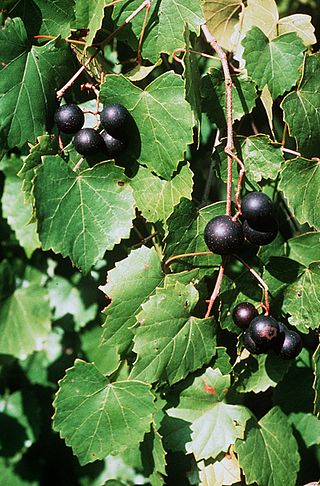
Vitis rotundifolia, or muscadine, is a grapevine species native to the southeastern and south-central United States. The growth range extends from Florida to New Jersey coast, and west to eastern Texas and Oklahoma. It has been extensively cultivated since the 16th century. The plants are well-adapted to their native warm and humid climate; they need fewer chilling hours than better known varieties, and thrive in summer heat.

Missouri wine refers to wine made from grapes grown in Missouri. German immigrants in the early-to-mid-19th century founded the wine industry in Missouri, resulting in its wine corridor being called the Missouri "Rhineland". Later Italian immigrants also entered wine production. In the mid-1880s, more wine was produced by volume in Missouri than in any other state. Before prohibition, Missouri was the second-largest wine-producing state in the nation. Missouri had the first area recognized as a federally designated American Viticultural Area with the Augusta AVA acknowledged on June 20, 1980. There are now four AVAs in Missouri. In 2017 there were 125 wineries operating in the state of Missouri, up from 92 in 2009.

Bordeaux wine is produced in the Bordeaux region of southwest France, around the city of Bordeaux, on the Garonne River. To the north of the city, the Dordogne River joins the Garonne forming the broad estuary called the Gironde; the Gironde department, with a total vineyard area of 110,800 hectares, is the largest wine-growing area in France.

French wine is produced all throughout France, in quantities between 50 and 60 million hectolitres per year, or 7–8 billion bottles. France is one of the largest wine producers in the world, along with Italian, Spanish, and American wine-producing regions. French wine traces its history to the 6th century BCE, with many of France's regions dating their wine-making history to Roman times. The wines produced range from expensive wines sold internationally to modest wines usually only seen within France such as the Margnat wines of the post war period.
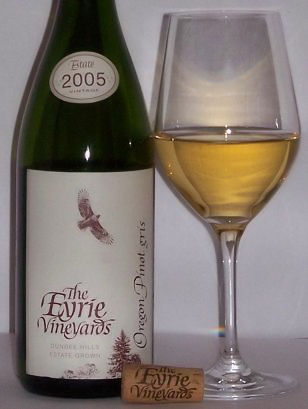
Wine has been produced in the United States since the 1500s, with the first widespread production beginning in New Mexico in 1628. Today, wine production is undertaken in all fifty states, with California producing 84 percent of all US wine. The North American continent is home to several native species of grape, including Vitis labrusca, Vitis riparia, Vitis rotundifolia, and Vitis vulpina, but the wine-making industry is based almost entirely on the cultivation of the European Vitis vinifera, which was introduced by European settlers. With more than 1,100,000 acres (4,500 km2) under vine, the United States is the fourth-largest wine producing country in the world, after Italy, Spain, and France.

New York wine refers to wine made from grapes grown in the U.S. state of New York. New York ranks third in grape production by volume after California and Washington. 83% of New York's grape area is Vitis labrusca varieties. The rest is split almost equally between Vitis vinifera and French hybrids.

New Mexico has a long history of wine production, within American wine, especially along the Rio Grande, from its capital Santa Fe, the city of Albuquerque with its surrounding metropolitan area, and in valleys like the Mesilla and the Mimbres River valleys. In 1629, Franciscan friar García de Zúñiga and a Capuchín friar named Antonio de Arteaga planted the first wine grapes in Santa Fe de Nuevo México, in what would become the modern Middle Rio Grande Valley AVA. Today, wineries exist in the aforementioned Middle Rio Grande Valley, as well as the Mesilla Valley AVA and the Mimbres Valley AVA.
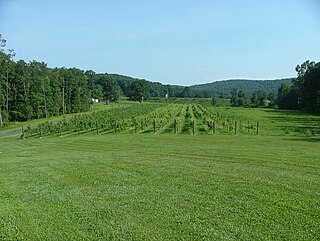
Wine has been produced in the North Carolina area since the early days of European colonization in the 17th century. Wine growers in North Carolina were the first to cultivate a Native American grape variety, the Scuppernong, which produces a sweet wine, examples of which are still being made in the state. Most wine produced in North Carolina since the year 2000 is made from Vitis vinifera grape varieties, although French hybrid and Vitis labrusca varieties remain common.

Pennsylvania wine refers to wine made from grapes grown in the Pennsylvania.

Wisconsin wine refers to wine made from grapes grown in the U.S. state of Wisconsin. Wisconsin is part of the largest American Viticultural Area (AVA), the Upper Mississippi Valley AVA, which includes southwest Wisconsin, southeast Minnesota, northeast Iowa, and northwest Illinois. The state also has two smaller designated American Viticultural Areas, the Lake Wisconsin AVA and the Wisconsin Ledge AVA.

Kentucky wine refers to wine made from grapes grown in the U.S. commonwealth of Kentucky. About 65 wineries operate commercially in Kentucky, with most recent plantings focusing on Cabernet Sauvignon, Chardonnay, and Cabernet Franc. Kentucky produced over two million gallons of wine in 2011 and is the largest wine-producing state by volume in the American South. Kentucky passed legislation in 1976 allowing wineries to operate, and tobacco settlement funds have provided Kentucky farmers the opportunity to once again explore grapes as a cash crop.

Oklahoma wine refers to wine made from grapes grown in the U.S. state of Oklahoma. Wine production was a significant component of the Oklahoma agricultural economy in the 1920s. The industry was destroyed by the Dust Bowl of the 1930s and the introduction of Prohibition in the United States. Oklahoma currently has about 52 wineries. Most of the wineries are located in Green Country, Lincoln county and surrounding areas in east central Oklahoma, Central Oklahoma and Southwest Oklahoma.

Georgia wine refers to wine made from grapes grown in the U.S. state of Georgia. Georgia was an important winegrowing region of the United States in the 19th century, and by 1900 ranked sixth in production among U.S. states.

Kansas wine refers to wine made from grapes grown in the U.S. state of Kansas. In the nineteenth century Kansas was a significant grape-growing state. Its latitude, long, sunny growing season and soils ranging from limestone-laced to sandy, can provide favorable conditions for growing grapes if the suitable varieties are planted.

Mississippi wine refers to wine made from grapes grown in the U.S. state of Mississippi. The hot and humid climate of Mississippi makes it very difficult to cultivate vitis vinifera or French hybrid grapes. The three commercial wineries in Mississippi focus almost entirely on the Muscadine grape, a variety also used for non-alcoholic grape juices, jams, and jellies. Most of the Mississippi Delta AVA, a designated American Viticultural Area, lies within the state boundaries of Mississippi.

Nebraska wine is wine made from grapes grown in the U.S. state of Nebraska. Nebraska's oldest winery was founded in 1994, and about thirty-five commercial wineries operate across the state. Wine quality varies across the state, however several wineries have won Best of Show titles during the States first 25 years of commercial wine production. Five of those titles were won with wines made of the states #1 wine produced from the Variety Edelweiss. Other wins were made with a dry Brianna, Vignole and a Marechel Foch Rose' wine. The vast majority of these wineries are small and sell most of their wine to tourists who visit the winery in person. The University of Nebraska–Lincoln has a program in viticulture. There are no designated American Viticultural Areas in Nebraska.
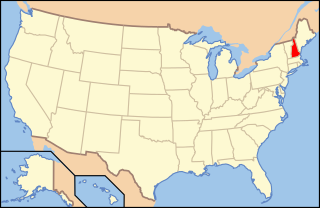
New Hampshire wine refers to wine made from grapes grown in the U.S. state of New Hampshire. The wine industry in New Hampshire began in 1994 when two wineries, Jewell Towne Vineyards and Flag Hill Winery, each produced their first vintages from locally grown grapes. Candia Vineyards started their test plantings in 1992, and full planting in 1998. New Hampshire continues to be growing wine-producing state, with new commercial wineries opening. The state currently has no American Viticultural Areas.
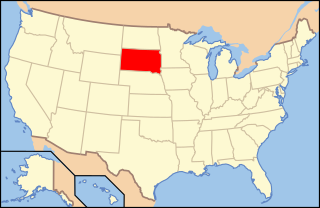
South Dakota wine refers to wine made from grapes grown in the U.S. state of South Dakota. Its region stretches between the latitudes of 42°N and 45°N sharing these latitudes with some of the most famous wine-producing areas in the world, including Bordeaux and Italy's Tuscany. South Dakota has a small wine industry, which must contend with extremes of heat in the summer and cold in the winter. The only grape species that naturally performs well in South Dakota is Vitis riparia, a species not generally used for wine production. The wineries in South Dakota have focused exclusively on cold-resistant French hybrid grapes. At present, there are no American Viticultural Areas (AVAs) in South Dakota, save for the state-level appellation.
Blanc du Bois is an American hybrid grape that was created in 1968 by John A. Mortensen at the University of Florida’s Central Florida Research and Education Center in Leesburg, Florida. Mortensen created this variety by crossing various Vitis vinifera grape varieties such as Golden Muscat with native Florida varieties. When released in 1987, Blanc du Bois became another grape variety in the small but growing number of vine types that can both produce marketable wine on their own yet can withstand Pierce's Disease, a bacterial infection that destroys nearly all vinifera vinestocks imported into the southern United States.



















